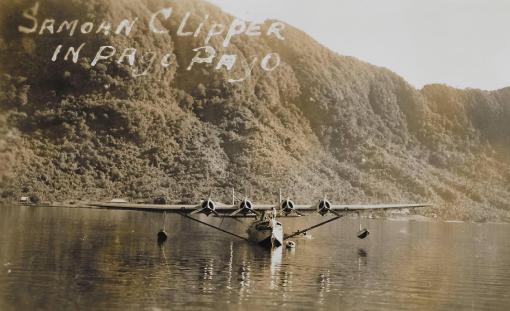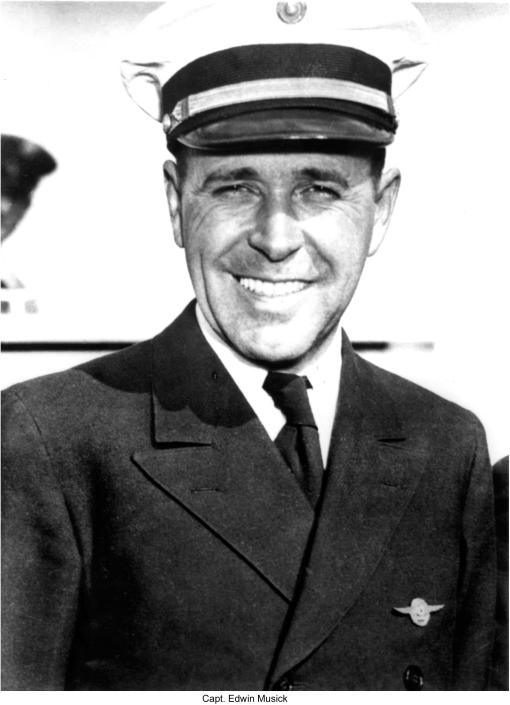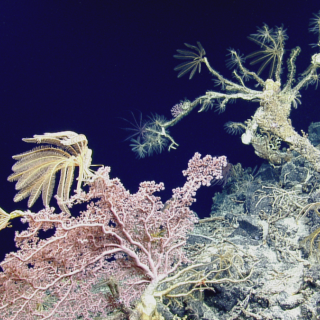Searching the Seafloor and Community Memory for the Samoan Clipper

This blog was written by Russ Matthews, President of the Air/Sea Heritage Foundation
The E Mamana Ou Gataifale II expedition will explore American Samoan waters to address a variety of local community and global scientific community-developed priorities, including better understanding Vailuluʻu Seamount, unexplored seamounts, bottom fish habitats, areas of a historic volcanic eruption around the Manu’a Islands, abyssal plains, and search for the Samoan Clipper underwater cultural heritage site.
The E Mamana Ou Gataifale II expedition is led by Ocean Exploration Trust and funded by NOAA Ocean Exploration, NOAA Office of Marine and Aviation Operations Uncrewed Systems Operations Center, and the Bureau of Ocean Energy Management via the Ocean Exploration Cooperative Institute in partnership with the National Marine Sanctuary of American Samoa and with support from Woods Hole Oceanographic Institution and Air/Sea Heritage Foundation.
The expedition’s plan was co-developed with input from American Samoan resource managers, scientists, educators, cultural practitioners, and other stakeholders, including through a March 2024 workshop convening government and agency representatives at the National Marine Sanctuary of American Samoa on Tutuila.
Of the many worthy objectives for the E Mamana Ou Gataifale II expedition, I’ve been most looking forward to once again working with the incredible team aboard E/V Nautilus to resume our ongoing search for the Samoan Clipper, one of the most historically significant lost aircraft in the Pacific. This component of the current mission represents a highlight in the now decade-long archival and field research effort spearheaded by my nonprofit Air/Sea Heritage Foundation (ASHF) and Ocean Exploration Trust (OET), now supported by NOAA Ocean Exploration and NOAA Office of Marine and Aviation Operations Uncrewed Systems Operations Center via the Ocean Exploration Cooperative Institute with the addition of Woods Hole Oceanographic Institution and their Autonomous Underwater Vehicle (AUV) Sentry team. The search for the Samoan Clipper continues to be a major priority for the National Marine Sanctuary of American Samoa and experts worldwide in understanding and managing the underwater cultural heritage of American Samoa’s waters.
The downed plane, a Sikorsky S-42B type flying boat operated by Pan American Airways, was the first commercial airliner to land in American Samoa. It was reportedly last seen just a few miles off the shores of Tutuila on January 11, 1938, where it crashed shortly after takeoff from Pago Pago harbor. Pan Am Chief Pilot Edwin C. Musick was attempting to inaugurate regular air mail service between Hawaiʻi and New Zealand when he was killed in the accident along with all six other members of his pioneering crew. Searchers responding to the scene a day later found a fuel slick and small pieces of debris floating on the ocean surface, but the fallen aviators and the sunken wreckage of their plane lay far beyond reach.

A new and active search for the Samoan Clipper initiated by Air/Sea Heritage Foundation has sought to apply archival research, innovative technology, and fresh analysis to tackle this challenge. In 2019 we partnered with OET to conduct a towed sonar survey from E/V Nautilus that studied the immediate vicinity of the reported crash site but was limited in scope by the tethered system that was available at that time. The wreck eluded us. Building on this foundation, ASHF seized an opportunity in late 2023 to work with Deep Sea Vision to deploy an AUV that sonar imaged nearly ten times more territory in “wide area mode.” The gathered data revealed a complex, fascinating, and daunting submerged landscape of vast plains, steep slopes, ravines, craters, seamounts, and boulder fields, but no obvious signs of sunken aircraft wreckage.
In the runup to the E Mamana Ou Gataifale II expedition, a careful review of all available evidence was conducted with an eye to defining the prime target area. Researchers combed through piles of old reports, logs, charts, and articles for every possible scrap of information. Combined with detailed computer modeling based on extensive NOAA weather and ocean current observations in the region, this study suggested prioritizing a stretch of water SE of the commonly understood crash location. Interestingly, this move seems to emphasize another powerfully intriguing, yet little-understood historical source.
Investigators in 1938 relied heavily on the eyewitness testimony of an unnamed American Samoa woman as they tried to comprehend the tragedy that overtook the Samoan Clipper. According to her riveting first-hand account, she was traveling by boat from Fagasa to Aʻasu when the aircraft flew low overhead dumping gasoline before suddenly diving toward the water and exploding in a flash of fire and smoke. This story was considered extremely reliable because she had told it to her matai (village chief) before the news reached their village that a plane was known to be missing. Unfortunately, her identity and that of other American Samoan witnesses said to have observed parts of the Clipper’s final flight were never recorded.
As we seek to expand the investigation, learning further details of those lost memories and experiences could help focus our efforts. Our team believes the expertise and knowledge of the people of American Samoa may yet hold a key clue to finding this important cultural heritage site. As part of the search, we invite community members to share their stories, those passed down through generations, or personal stories about this important era, as American Samoa held a key place in aviation history connecting the Pacific through air travel.
Anyone with information is encouraged to visit the Tauese P.F. Sunia Ocean Center in Utulei. You may also submit leads, anecdotes, memories, photos, or writings about the eyewitness, her story, the loss of the plane, or anything related to Pan Am’s time in Pago Pago between March 1937 and January 1938 through the ASHF website by clicking on the CONTACT link and selecting “Samoan Clipper – Share your story” from the drop-down Subject menu.

In the meantime, our work continues. The team aboard E/V Nautilus will deploy AUV Sentry on a pair of deep diving missions, scanning the ocean floor near the approximate position of the eyewitness. The vehicle will cover as much ground as possible, moving in a regular pattern of staggered sonar lines to try and intersect traces of the aircraft debris field. Operating near the seabed will increase the resolution of resultant survey data, even when flying at depths below 3,000 meters (9,800 feet). If promising clues are revealed in the sonar imagery, further exploration may continue with possible follow-up ROV dive(s) near the end of the E Mamana Ou Gataifale II expedition.
Together, we hope to write a final and conclusive chapter to the Samoan Clipper’s remarkable story.

E Mamana Ou Gataifale II - American Samoa
American Samoa is the southernmost U.S. territory, centered in the South Pacific, 2,300 miles southwest of Hawaiʻi, and 1,500 miles northeast of New Zealand. It is home to the cradle of Polynesia’s oldest culture.



